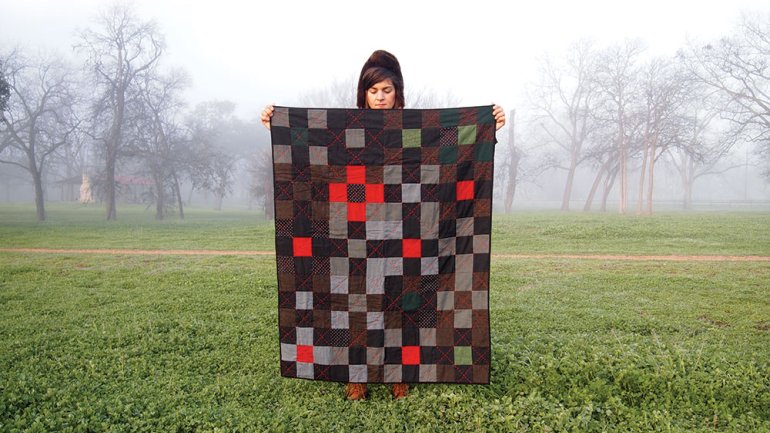Pieces of a Whole
Pieces of a Whole
Seven years ago, when Maura Grace Ambrose was making her first quilt, she ran into a problem: She couldn’t bear to send it through a sewing machine to finish it.
“The process just felt terrible to me,” she says. She pictured forcing layers of fabric under the presser foot and how the fibers would bunch and bind, surrendering to the pounding needle. She decided to stitch it by hand, but that made for another first: missing her deadline. The quilt was for a class at Savannah College of Art and Design, where she was majoring in textile design and fiber art.
The professor had provided ample time to machine-quilt, but hand-quilting is a time-consuming process, especially for a novice. “I was shocked at how long it took,” Ambrose admits, “but it was worth it.” By stitching the quilt herself, she felt she would honor the history of the form while embracing the accidental beauty of things made by hand. It was a turning point – she just didn’t know it yet.
Today, Ambrose is an accomplished full-time quilt artist based in Austin, Texas, creating “modern heirlooms” for her company, Folk Fibers. Her contemporary designs pay homage to early American quilts, Amish textiles, and African American quilting tradition. She’ll take a classic pattern – say, log-cabin block or sawtooth square – and make it hers, playing with scale, texture, and color. She uses both new and vintage fabrics, many dyed with plants she’s grown or foraged. The result is a graphic, fresh approach to a classic art form.
Post-SCAD, Ambrose had a portfolio of quilted works made with naturally dyed fabrics, and, from the outside, her path might have seemed clear. But instead of pursuing textiles, Ambrose tried her hand at fashion, landing an entry-level job at Free People, a trendy, high-end clothing line in Philadelphia. It was a big break, but sitting in front of a computer, Ambrose almost immediately felt adrift. “I knew I didn’t quite belong,” she says.
She found work at a preschool that emphasized creative expression; then, in 2010, she relocated to Austin and began working on an organic farm. She jokes that income is supposed to increase over time, but hers never did. Instead she’s been on a trajectory of increasing satisfaction. On the farm, she learned about the intricacies of organic agriculture, while deepening a physical work ethic that’s apparent today in the hundreds of fine stitches that cover her one-of-a-kind quilts. The idea to make those quilts her livelihood struck in 2011, during a cross-country road trip with her husband in their red Volks¬wagen bus. They soaked up America: the people, the artifacts, the way of life. “When you’re on the road for that long, you have a lot of time to think,” Ambrose says.
It all became clear: Her background in textile design and her love of Americana; her experience in natural dyeing, combined with new skill in cultivating plants; and that instinctive impulse to hand-finish her first quilt. “It’s simple now,” she says. “It just took me a lot of time to sort out.”
As a young business, Folk Fibers has found quick – and high-profile – success. Shortly after launching, Ambrose caught the eye of a creative director at Levi Strauss, who invited her to produce quilts for the company’s Made Here stores. The bespoke boutiques focus on locally and/or handmade goods. (Ambrose has a small group of trusted local sewers who help with the workload as needed.) She’s also been on high-traffic blogs such as Design*Sponge and in mainstream magazines, including Country Living.
When she’s not in the studio, Ambrose is in her garden, where she currently tends more than 500 indigo plants, which yield a direct dye – colorfast without chemical additives. She also scavenges for walnut husks and prickly pear, and keeps up relationships with local farmers who donate the onion skins that round out her dye repertoire. Each Folk Fibers quilt is one of a kind, bearing the imprint of the season in which it was made, the dye sources and fabrics that were available, and Ambrose’s inspiration in the moment.
The positive reception has been rewarding. But after the long journey that led her to Folk Fibers, Ambrose doesn’t plan to lose sight of where she began. “I breathed a little business into the world of quilting, and it got really big for me,” she says.
“I realize now [what I have always been seeking is] balance. I want to return to the roots of my business and quilt. I want to build a community around me.”
Cortney Heimerl is a writer in Milwaukee.

